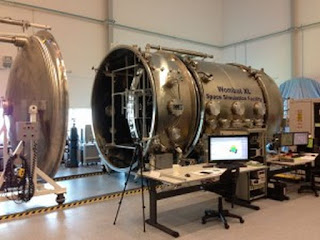Part 1 - Canberra August, 2004
"I've always been really interested in recreating space phenomenon in the laboratory. It's very difficult to measure in space to measure the aurora although it is a true wonder in seeing these lights in the sky. But to simulate this in the laboratory, to do experiments on it and then try and understand what is happening I think for me is one of the greatest joys that we've been given", said Dr Rod Boswell.First you make the plasma by zapping a gas with radio waves - "microwaving" it. The atoms change into electrically charged particles called ions. Cut the end of the tube and the ions all shoot out, creating thrust - plasma thrust.
"This is Wombat. It's called wombat because it's got four legs and sort of looks like a wombat. You can see here we create a plasma, this is the glowing gas you can see in the end there. So the plasma's created here then moves into space. And if you look in there, ah, it always amazes me. There's this blue column of plasma which is shooting out from the plasma source," Rod explained.
Rod made quite an impression around the world with his Wombat plasma generator. NASA took some of his ideas to design tiny satellite guidance thrusters.
Anxious to find new ways to make plasma thrusters work better, Rod assembled a team of young physicists, and encouraged an atmosphere of ideas and creative thought.
"I came here to ANU because I thought that this is one of the top laboratories in the world. The environment is just perfect and it's really good for creativity," explained Dr Christine Charles.
 |
| Professor Christine Charles Head of the Space Plasma, Power and Propulsion Laboratory Australian National University |
Rod had recently commissioned a new, improved version of wombat, and Christine was eager to try it out, to see if she could, amongst other things, recreate an aurora in the lab. One day, impatient for results, Christine decided to play with the settings. She was amazed with what happened next.
"I'll show you. Normally this is standard plasma, but on the day, instead of doing what everyone does which is turn the knob on, turn the power on, and see what happens, I did the opposite. I turned the power down and I reduced the flow down. So then you need to increase the magnetic field to be able to contain it. So you do that, you make the measurements with the ions... Look at this, there it is. The hot ions, the plasma is suddenly accelerating, all by itself. It appeared to be in free fall, travelling much faster then I'd ever seen before. And I kept getting this result, and I thought, oh, this is like, oh! What's happening!" Christine recalled.
"The plasma behaves like water tumbling over a cliff, getting faster as it drops. And, just like an aurora, it seems that the plasma actually makes the 'cliff' - all by itself. It's almost magic."
"What Christine found is that under certain conditions instead of just flowing out smoothly it creates this jump, and the ions fall down this, and it's like having two electrodes that accelerate the ions like in an accelerator, but there are no electrodes! The plasma itself forms an acceleration mechanism. It's actually a wonder," said Rod.



0 comments:
Post a Comment